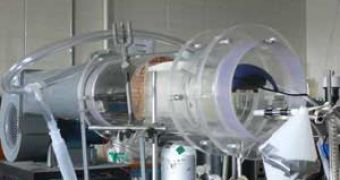As a result of global warming, due to large quantities of greenhouse gases being dumped every year in the Earth's atmosphere, researchers are constantly developing new techniques and technologies to pull the excess carbon dioxide and other greenhouse gases out of the atmosphere.
The carbon dioxide gas is only one of the many gases that produce global warming. It prevents the reflection of light coming from the Sun back into space, thus heating ever more the clime. Currently the industry produces about 27 billion tons of gas every year, out of which more than a quarter is produced by the U.S. In the last decades inventors created carbon dioxide scrubbers to act as filters against the emission produced by power plants, which produce about half of the carbon dioxide thrown into the atmosphere.
Humanity tries now to deal with the other half of carbon dioxide emission, produced by cars and other sources. Some of the solutions involve influencing the oceans and seas in order for them to absorb more of the carbon dioxide gas.
Environmental engineer Frank Zeman from the Columbia University proposes a radical new technology through which air is forced through cylinders coated with a sodium hydroxide solution, which has the capability of absorbing the carbon dioxide out of the air. After the solution reached its saturation point, it would be mixed up with line to create lime stone, out of which the carbon dioxide gas can be extracted by baking and stored.
This process is similar to that used in the paper making industry, where wood is doused with lye to soften it, after which the fluid filled with carbon is mixed to lime. Because this method has been used for a long time in some parts of the industry, it has the advantage that it could be put into practice relatively fast.
However, the gas sucking device must be powered through other methods, rather than using fossil fuel burning processes, such as tidal or wind power. Even if the device is plugged directly into the power grid, through which most of the electric power that circulates is produced out of burning fossil fuel, it will still be effective in capturing 100 tons of carbon dioxide for every 20 tons of gas the power plants emit.
Calculations show that carbon dioxide capturing facilities roughly the size of nuclear power plants could handle about 2.2 billion metric tons of gas, equivalent with the quantity eliminated by all transportation systems in the U.S. in a year, which could be absorbed with the aid of 200 towers.
Other studies in this domain, such as that conducted at the Swiss Federal Institute of Technology, involve techniques that use the heat radiated by the Sun, to help different compounds to absorb the carbon dioxide gas from the air.
Such techniques may serve as an excuse for further use of fossil fuels, since the alternative fuel sources demand that all the machinery working on burning fossil fuels needs converting for hydrogen use or other alternative non-pollutant fuels.

 14 DAY TRIAL //
14 DAY TRIAL //